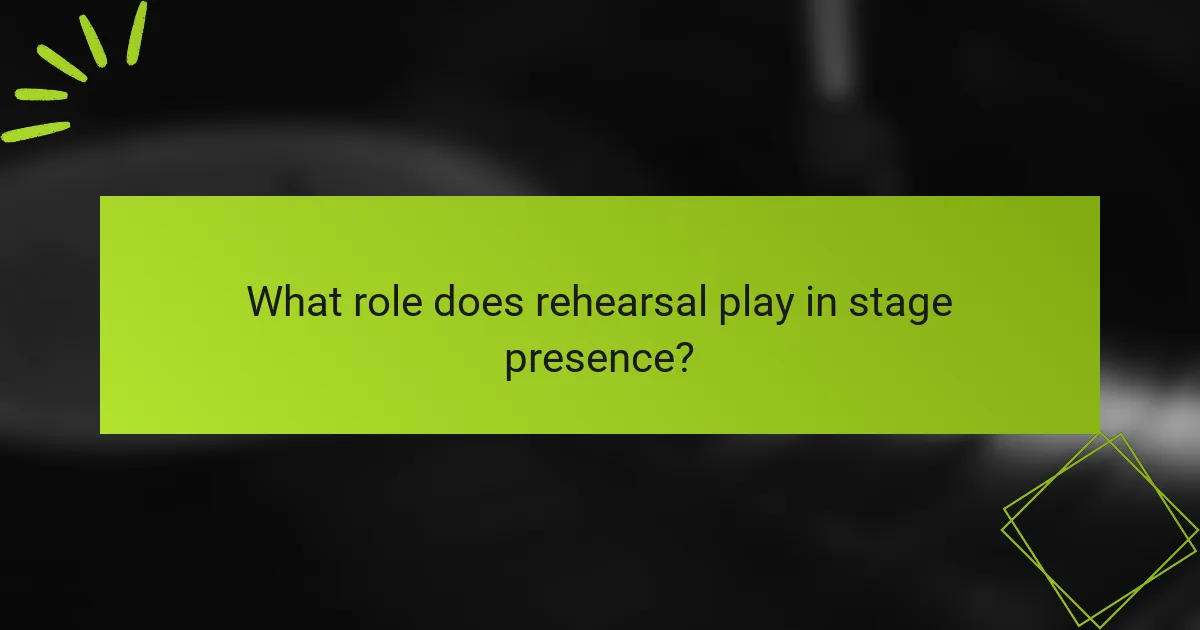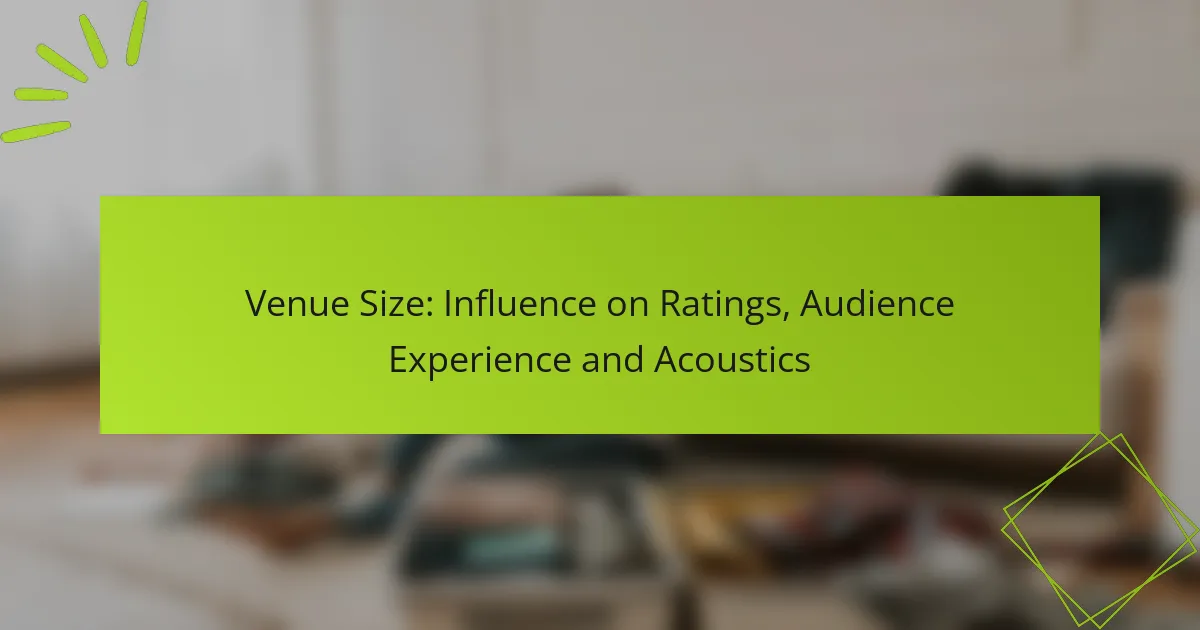Stage presence is a vital component of any performance, encompassing techniques that captivate audiences and leave a lasting impression. By mastering elements such as body language, vocal dynamics, and storytelling, performers can forge a strong emotional connection with their viewers, enhancing the overall experience. Engaging with the audience and responding to their energy is essential for creating a memorable and impactful performance.

How to Enhance Stage Presence for Performers?
Enhancing stage presence involves mastering various techniques that captivate the audience and create a memorable performance. Key factors include body language, audience engagement, vocal dynamics, storytelling, and effective use of lighting.
Practice body language techniques
Body language is crucial for conveying emotions and intentions to the audience. Performers should focus on maintaining an open posture, using gestures that complement their message, and making eye contact to establish a connection. Regular practice in front of a mirror or recording oneself can help identify areas for improvement.
Consider incorporating movements that align with the performance’s theme. For instance, a dramatic piece may benefit from strong, deliberate gestures, while a light-hearted performance might use more fluid and playful movements.
Engage with the audience
Engaging with the audience transforms a performance into an interactive experience. This can be achieved by asking questions, inviting participation, or acknowledging audience reactions. Simple techniques like smiling and nodding can foster a sense of connection.
Performers should also read the room and adjust their approach based on audience feedback. If the crowd seems enthusiastic, amplifying energy levels can enhance the overall atmosphere. Conversely, a more subdued audience may require a different strategy to draw them in.
Utilize vocal dynamics
Vocal dynamics play a significant role in maintaining audience interest. Varying pitch, volume, and pace can emphasize key points and convey emotions effectively. Practicing these elements can help performers avoid monotony and keep the audience engaged.
For example, raising the volume during a climactic moment can heighten tension, while softening the voice can create intimacy. Performers should experiment with their vocal range to find what resonates best with their style and the performance context.
Incorporate storytelling elements
Storytelling is a powerful tool for enhancing stage presence. By weaving narratives into performances, artists can create emotional connections and keep the audience invested. This can involve sharing personal anecdotes or crafting fictional tales that resonate with the audience’s experiences.
Effective storytelling often includes relatable characters, conflict, and resolution. Performers should focus on clarity and pacing to ensure the story unfolds smoothly, allowing the audience to follow along easily.
Leverage stage lighting
Stage lighting significantly impacts the mood and focus of a performance. Utilizing different lighting techniques can highlight performers, create atmosphere, and guide audience attention. For instance, spotlights can draw focus to a soloist, while softer lighting can create a more intimate setting.
Performers should collaborate with lighting technicians to design a lighting plan that complements their performance. Understanding how various colors and intensities affect emotions can enhance the overall impact, making the performance more memorable for the audience.

What are the key factors of effective stage presence?
Effective stage presence is characterized by a combination of confidence, physicality, and emotional connection with the audience. These elements work together to create a memorable performance that engages and captivates viewers.
Confidence and charisma
Confidence is essential for effective stage presence; it conveys authority and helps to engage the audience. Charisma complements confidence by adding a magnetic quality that draws people in. Performers can enhance their confidence through preparation, practice, and positive visualization techniques.
To project confidence, maintain good posture, make eye contact, and use a strong, clear voice. Avoid fidgeting or excessive movements that can detract from your message. Remember, the audience is more likely to connect with a performer who appears self-assured and comfortable on stage.
Physicality and movement
Physicality refers to how performers use their bodies to express emotions and ideas. Effective movement can enhance storytelling and keep the audience engaged. Consider using gestures, facial expressions, and purposeful movements to emphasize key points in your performance.
Be mindful of your stage space; use it to your advantage by moving to different areas to create visual interest. However, avoid overdoing it—excessive movement can distract from your message. Aim for a balance between stillness and movement to maintain audience focus.
Emotional connection
Establishing an emotional connection with the audience is crucial for effective stage presence. This connection can be fostered through authenticity and vulnerability, allowing the audience to relate to the performer on a personal level. Share stories or experiences that resonate with your audience to create a shared emotional experience.
Active listening and responding to audience reactions can also strengthen this connection. Adjust your performance based on their feedback, whether it’s laughter, applause, or silence. Building this rapport can make your performance more impactful and memorable.

How to connect with the audience during performances?
Connecting with the audience during performances is essential for creating an engaging experience. This involves actively engaging with the crowd, making them feel included, and responding to their energy and reactions.
Establish eye contact
Establishing eye contact is a powerful way to connect with your audience. It creates a sense of intimacy and shows that you are present and engaged with them. Aim to make eye contact with different sections of the audience throughout your performance to foster a sense of connection.
To enhance this connection, try to hold eye contact for a moment before moving on. This can make individuals feel acknowledged and valued, encouraging them to engage more with your performance.
Encourage audience participation
Encouraging audience participation can significantly enhance the connection between you and the crowd. This can be done through call-and-response techniques, inviting questions, or even incorporating audience members into your performance. Such interactions make the audience feel like active participants rather than passive observers.
Consider using simple prompts or activities that are easy for the audience to engage with. For example, asking them to clap along or shout out responses can energize the atmosphere and strengthen the bond between you and your audience.
Read audience reactions
Reading audience reactions is crucial for adjusting your performance in real-time. Pay attention to facial expressions, body language, and vocal responses to gauge how your message is being received. This awareness allows you to modify your delivery or content to better resonate with the crowd.
Be prepared to pivot based on the audience’s energy. If they seem disengaged, consider changing your tone or introducing a more interactive segment. Conversely, if they are enthusiastic, you can build on that momentum to elevate the overall experience.

What role does rehearsal play in stage presence?
Rehearsal is crucial for developing stage presence, as it allows performers to practice their material and refine their delivery. Through consistent rehearsal, artists can build confidence, enhance their connection with the audience, and improve overall performance quality.
Build familiarity with the material
Familiarity with the material is essential for effective stage presence. When performers know their lines, cues, and choreography inside out, they can focus on engaging with the audience rather than worrying about forgetting their parts. Regular rehearsals help solidify this knowledge, allowing for a more natural and fluid performance.
Consider breaking down the material into manageable sections during rehearsals. This approach can help reinforce memory retention and make it easier to tackle complex pieces. Aim for multiple run-throughs to ensure that the content becomes second nature.
Refine performance techniques
Rehearsals provide an opportunity to refine various performance techniques, such as vocal projection, body language, and emotional expression. By practicing these elements, performers can discover what resonates best with their audience and adjust their delivery accordingly. This iterative process is vital for developing a strong stage presence.
Incorporate feedback from peers or directors during rehearsals to identify areas for improvement. Experiment with different styles and techniques to find the most effective ways to convey emotions and connect with the audience. Regular practice can lead to significant enhancements in performance quality.
Enhance comfort on stage
Comfort on stage is a key factor in establishing a strong stage presence. Rehearsing in the actual performance space, if possible, can help performers acclimate to the environment and reduce anxiety. Familiarity with the stage layout and audience sightlines can lead to more confident movements and interactions.
To further enhance comfort, consider incorporating relaxation techniques, such as deep breathing or visualization exercises, into rehearsal routines. These practices can help performers manage nerves and maintain focus, ultimately leading to a more engaging and authentic performance.

How can technology improve stage presence?
Technology can significantly enhance stage presence by providing tools that engage the audience and streamline performance delivery. By integrating various tech elements, performers can create a more dynamic and memorable experience that fosters a stronger connection with their audience.
Use of visual aids
Visual aids, such as slideshows, infographics, and props, can help clarify key points and maintain audience interest. They serve to reinforce spoken content, making it easier for the audience to retain information. For instance, using high-quality images or graphs can illustrate complex ideas succinctly.
When selecting visual aids, ensure they are relevant and not overly cluttered. Aim for a balance where visuals enhance rather than distract from your message. A good rule of thumb is to limit text on slides to a few bullet points, allowing the audience to focus on your delivery.
Incorporate multimedia elements
Incorporating multimedia elements like videos, music, or sound effects can elevate a performance by appealing to multiple senses. For example, a short video clip can provide context or emotional depth, while background music can set the tone for your message. These elements can create a more immersive experience for the audience.
However, it’s essential to ensure that multimedia elements are well-timed and relevant. Test all technology beforehand to avoid technical issues during the performance. A seamless integration of multimedia can enhance engagement, but disruptions can detract from your overall stage presence.



